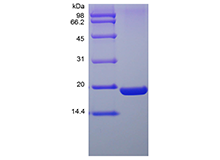Ubiquitin-conjugating Enzyme E2 I (UBE2I), also known as Ubiquitin-conjugating Enzyme 9 (UBC9) belongs to the ubiquitin-conjugating enzyme family and is encoded by the UBE2I gene in humans. The ubiquitin-conjugating enzymes, also known as E2 enzymes and more rarely as ubiquitin-carrier enzymes, take part in the second step in the ubiquitination reaction. In this reaction, E1 activates the ubiquitin by covalently attaching the molecule to its active site cysteine residue. The activated ubiquitin is then transferred to an E2 cysteine and then the E2 molecule binds E3 via a structurally conserved binding region. The UBE2I/UBC9 accepts the ubiquitin-like proteins SUMO1-4 from the UBLE1A-UBLE1B E1 complex and catalyzes their covalent attachment to other proteins with the help of an E3 ligase such as RANBP2 or CBX4. Additionally, it takes parts in catalysis the formation of poly-SUMO chains, sumoylation of FOXL2 and KAT5, and the segregation of nuclear architecture and chromosome.

